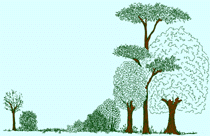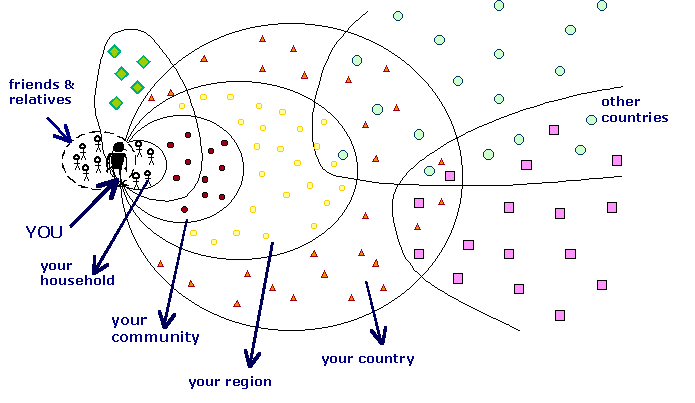 |
||
|
Information - how it arises |
The emphasis so far in zonal analysis has been on efficient placement of elements in a productive land use design. However, 80% of UK population is crammed into 15% of its landmass, and so our access to land is non-existent, or limited to allotments and gardens. This is despite the fact that over 75% of total UK land is used in agriculture and then by only some of the remaining 20% of population (the problem is the production of meat and milk which takes up nearly two-thirds of UK landmass). As individuals and as members of communities, we are sorely land-deprived. Few of us are ever likely to have access to sufficient land so that we could design a landscape that runs through all the zones out to wilderness. Instead, we concentrate on our home (ZONE 0) and making the most of what for some may only be a balcony or a paved backyard (ZONE 1). There is more we can do, and that is to apply permaculture design to our social organisation as well as to designing our physical environment. Thus the origins and use of information as a resource can be described through zonal analysis. Also, experience of working locally, regionally and nationally on issues of sustainability confirms to many that people and their organisations can also be described in this way. An understanding of the zonal analysis of information and of people can give a better understanding of how we may as individuals and collectively design for permanent beneficial change in society. INFORMATION (worthless if not used) Activities in different zones generate information, but the distinction is that it arises by natural processes in wilderness whereas it is stored or generated by people in ZONE 1. In wilderness (ZONE 5) we are literally students at the feet of Mother Nature. We observe natural systems and learn lessons that we may make use of in other zones. It is also certain that we may only know a fraction of what exists in wilderness, as we are still learning of new species and discover new properties in plants. We must, though, be careful in thinking that we can fundamentally improve on this wilderness information and on wilderness itself since evidence from the Earth’s history suggests that nature can bite back when we try to manage it, ignore it or try to insulate ourselves from it (i.e. poorly thought out conservation schemes, flooding due to loss of water management in landscapes, exploitation). True wilderness is rare in the UK because of the extent of farmland (see above) and for the lack of any land that has not been substantially transformed by people over the millennia. Unfortunately, farmers seem to abhor wilderness. They rationalise their land tenure, and their continued survival by subsidy, as being essential to keep wilderness at bay. This needs challenging since it is at the centre of insensitivity to biodiversity and to natural processes. Permaculturists are unafraid of wilderness since they see the purpose in it as an essential refuge, and a textbook from which we all learn. In ZONE 1 we are arranging the natural world to meet our needs. We tend species that we have selected and which have generally become dependent on us. (Most food crops will not thrive outside of cultivation, they will disappear eventually without establishing themselves naturally). Thus we become developers of information that we can then pass on to others when we act as a teacher. We are the experts in our ZONE 1. Information arises in other zones from our interaction with other sentient species (i.e. animal behaviour that we learn from and can make use of). PEOPLE (one of the major species on earth)
It is important to readjust your perception of the distance between zones in the zoning of people. In land-based zoning, they are walking distance from our centre of activity (home). The distances between people-based zones are much further since the zones are what we understand by local, regional and national –loosely ZONES 1, 3, & 5. Think about examples of the people activities that you get involved in locally. As in any ZONE 1, these have high frequency and energy associated with them. They could be you making connections with voluntary groups that have similar outlook, such as with sustainability or self-reliance at their core i.e. community food growing or distribution, a local sustainability network, a Local Exchange Trading Scheme, or a tenants and residents group. Is employment a ZONE 1 people activity? It qualifies on frequency and energy terms, but we may not always be able to include the ethics and principles of Permaculture in our everyday work. Permaculture talks about right livelihood. What this means is that we should all strive for employment that is not in itself destructive of the things around us (i.e. it is socially and environmentally responsible). Having taken on this people-based view of zonation, we can extend it into the other zones, ending in wilderness. Think again of examples of people-based activities that you may be involved in regionally and nationally. It is also important to see what effect regional and national activities have on our local activity. Thus what about the effect both national and regional government have on local government, in the same way that the national policy on sustainable development has influence on regional assembly plans and on local community strategies (the replacement for Local Agenda 21). Another example would be looking at food production and distribution, contrasting the merits of a local food economy with the food miles associated with regional and national systems. I cannot resist the temptation to describe the activities of national organisations as truly befitting their place in the "wilderness". Most of them have a poor feel for the needs and aspirations of local people because they rarely engage with local activity - they have little experience themselves. By using the analogy of a wildlife corridor in a land-based design, where wilderness infiltrates through all our zones, you may be able to identity national organisations that have the potential to reach your back door and thus should be supported. Membership of the Permaculture Association may be considered as one of those. Mark Fisher - Permaculture Design course handout notes www.self-willed-land.org.uk mark.fisher@self-willed-land.org.uk |
